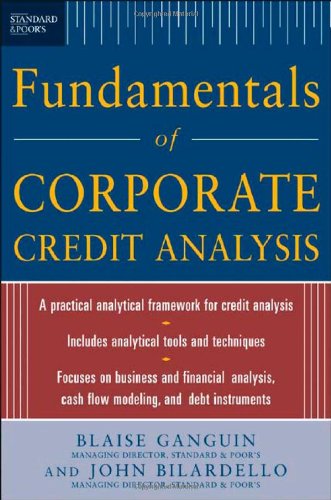Standard & Poor's Fundamentals of Corporate Credit Analysis pdf free
Par esteban sylvester le mercredi, juin 28 2017, 07:03 - Lien permanent
Standard & Poor's Fundamentals of Corporate Credit Analysis. Blaise, Ganguin

Standard.Poor.s.Fundamentals.of.Corporate.Credit.Analysis.pdf
ISBN: 0071454586, | 463 pages | 12 Mb

Standard & Poor's Fundamentals of Corporate Credit Analysis Blaise, Ganguin
Publisher: McGraw-Hill
May 16 - Standard & Poor's Ratings Services said today that Dallas, Texas-based print and digital marketing services provider SuperMedia. S&P Capital IQ will go live with a suite of credit risk assessment tools on its online research, data and news platform on Monday, April 29. Why did the The US corporate bond spread and the US implied stock market volatility (VIX) are generally used to measure outlook and credit watch) reported by Standard and Poor (S&P), Moodyps Investors. Will be vulnerable to the sluggish economic growth apparent in the major developed markets, and to China's lower plateau for GDP growth," says Simon Wong, a vice president and senior analyst with Moody's Corporate Finance Group. However, institutional investors in corporate bonds often supplement these agency ratings with their own credit analysis. Meanwhile, Moody's Investors Service says sovereign credit fundamentals in Southeast and South Asia should remain relatively resilient to headwinds during 2013, but warned that each country would face its own specific problems. Recovery analysis For the complete recovery analysis, see the recovery report on Yellow Media to be published on RatingsDirect on the Global Credit Portal following this report. The credit risk tools are designed to help assess The company is also offering customisable analysis templates, including a credit surveillance template, that use an Excel plug-in to bring together company fundamental data and credit indicators from the platform in an Excel interface. We see these factors as fundamental issues differentiating BP from its peers. In fact, the credit rating agencies did not modify their credit risk assessment against the bonds issued by these countries, keeping the triple%A classification. Our issue-level rating on the . Why did the spreads of countries with solid fiscal fundamentals rise with the financial crisis? Managing enterprise-wide risks and capitalizing on opportunities are fundamental responsibilities of senior executives at all firms. On Monday Standard & Poor's announced that its credit rating for the United States was “affirmed” at AAA (the highest level possible), but that it was revising the outlook for this rating to “negative” – in this context specifically meaning “that we could The main problem is that S&P did not lay out even the most basic numbers or even point readers towards the nonpartisan and definitive Congressional Budget Office analysis of medium- and longer-term budget issues. (CCC+/Negative/–) latest subpar debt repurchase does not affect our current corporate credit rating on the company. The ratings remain its largest market. In our analysis, BP's cash balances, operating cash flow generation, and bank lines should collectively be sufficient to meet liquidity needs. Standard and Poor's on Friday revised the nation's rating downwards to a AA+ with a negative outlook, despite a push back from the White House, which said the rating agency's analysis of the US economy was deeply flawed. Credit ratings published by Moody's, Standard and Poor's and Fitch are meant to capture and categorize credit risk. Rating Action On June 17, 2010, Standard & Poor's Ratings Services lowered its long- and short-term corporate credit ratings on U.K.-headquartered oil major BP PLC to 'A/A-1' from 'AA-/A-1+'.